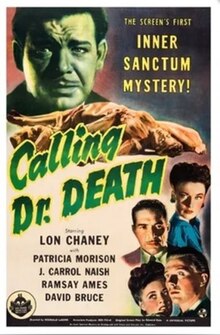Inner Sanctum Mystery, also known as Inner Sanctum, is a popular old-time radio program that aired from January 7, 1941, to October 5, 1952. It was created by producer Himan Brown and was based on the imprint given to the mystery novels of Simon & Schuster. In all, 526 episodes were broadcast.
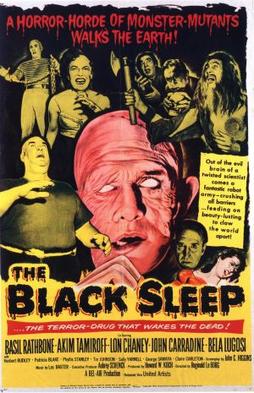
The Black Sleep a 1956 American independent horror film directed by Reginald LeBorg, and written by John C. Higgins from a story by Gerald Drayson Adams. It stars Basil Rathbone, Lon Chaney Jr., John Carradine, Bela Lugosi, and Akim Tamiroff. Tor Johnson appears in a supporting role. The film was produced by Aubrey Schenck and Howard W. Koch, as part of a four-picture finance-for-distribution arrangement with United Artists.
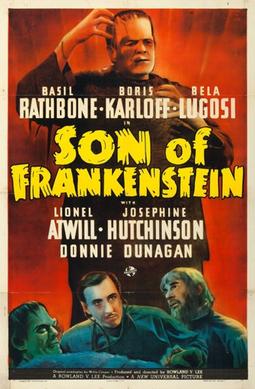
Son of Frankenstein is a 1939 American horror film directed by Rowland V. Lee and starring Basil Rathbone, Boris Karloff and Bela Lugosi. The film is the third in Universal Pictures' Frankenstein series and is the follow-up to the 1935 film Bride of Frankenstein. Son of Frankenstein stars Rathbone as Baron Wolf von Frankenstein who, with his wife Elsa and son Peter, returns to his late father's estate. Near the castle lives Ygor, a crazed blacksmith whose neck was broken in an unsuccessful hanging attempt. Among the castle's remains, Frankenstein discovers the remains of the Monster and decides to try to save his family name by resurrecting the creature to prove his father was correct. He finds, however, the Monster only responds to Ygor's commands.

The Invisible Ray is a 1936 American science-fiction horror film directed by Lambert Hillyer. It stars Boris Karloff as Dr. Janos Rukh, a scientist who comes in contact with a meteorite composed of an element known as "Radium X". After exposure to its rays begins to make him glow in the dark, his touch becomes deadly, and he begins to be slowly driven mad. Alongside Karloff, the film's cast includes Bela Lugosi, Frances Drake, Frank Lawton, Walter Kingsford, Beulah Bondi, Violet Kemble Cooper, and Nydia Westman.
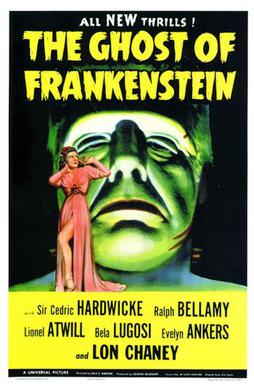
The Ghost of Frankenstein is a 1942 American horror film directed by Erle C. Kenton and starring Cedric Hardwicke, Lon Chaney Jr. and Bela Lugosi. It is the fourth film in the Frankenstein series by Universal Pictures, and the follow-up to Son of Frankenstein (1939). The film's plot follows the previous film's: Frankenstein's Monster and his companion Ygor are chased out of town. They go to another small town to encourage the younger son of Henry Frankenstein to continue his father's experiments, so that Ygor can have revenge against his enemies and his brain transplanted into the Monster's skull.

Frankenstein Meets the Wolf Man is a 1943 American horror film directed by Roy William Neill and starring Lon Chaney Jr. as Larry Talbot and Bela Lugosi as Frankenstein's monster. The script, written by Curt Siodmak, follows The Ghost of Frankenstein and The Wolf Man, though with a number of retcons. Most significantly, Talbot only transforms into werewolf form during a full moon, which became a standard part of werewolf lore. The film involves Larry Talbot, who is resurrected when his tomb is disturbed. His search for a way to end his seeming immortality leads to his befriending Frankenstein's monster.

Son of Dracula is a 1943 American horror film directed by Robert Siodmak with a screenplay based on an original story by his brother Curt Siodmak. The film stars Lon Chaney Jr., Louise Allbritton, Robert Paige, Evelyn Ankers, and Frank Craven. The film is set in the United States, where Count Alucard has just taken up residence. Katherine Caldwell (Allbritton), a student of the occult, becomes fascinated by Alucard and eventually marries him. Katherine begins to look and act strangely, leading her former romantic partner Frank Stanley (Paige) to suspect that something has happened to her. He gets help from Dr. Brewster (Craven) and psychologist Laszlo who come to the conclusion that Alucard is a vampire.

House of Frankenstein is a 1944 American horror film starring Boris Karloff, Lon Chaney Jr. and John Carradine. It was directed by Erle C. Kenton and produced by Universal Pictures. Based on Curt Siodmak's story "The Devil's Brood", the film is about Dr. Gustav Niemann, who escapes from prison and promises to create a new body for his assistant Daniel. Over the course of the film, they encounter Count Dracula, the Wolf Man and Frankenstein's monster. The film is a sequel to Frankenstein Meets the Wolf Man (1943).
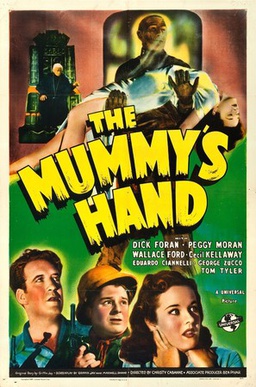
The Mummy's Hand is a 1940 American horror film directed by Christy Cabanne and produced by Ben Pivar for Universal Studios. Shot in black-and-white, the film is about the ancient Egyptian mummy of Kharis, who is kept alive with a brew of tana leaves by The High Priest and his successor Andoheb. Meanwhile, archeologists Steve Banning and Babe Jenson persuade magician Solvani to finance an expedition in search of the tomb of Princess Ananka. They are joined by Solvani's daughter Marta, and followed by Andoheb who is also the professor of Egyptology at the Cairo Museum. Kharis is ordered to kill off expedition members Dr. Petrie and Ali, while Andoheb becomes attracted to Marta who he plans to kidnap and make immortal.

The Mummy's Tomb is a 1942 American horror film directed by Harold Young and starring Lon Chaney Jr. as Kharis the mummy. Taking place 30 years after the events of The Mummy's Hand, where Andoheb has survived and plans revenge on Stephen Banning and his entire family in Mapleton, Massachusetts. With the help of the high priest Mehemet Bey, Andoheb and the mummy Kharis Bey takes up a job as a caretaker of a graveyard. At the first full moon, the mummy is fed tanna leaves which allow him to break into the Banning residence and kill the now elderly Stephen. Banning's son then seeks assistance from Babe Hanson, one of the members of the original Banning expedition to Egypt to stop Andoheb and Kharis.
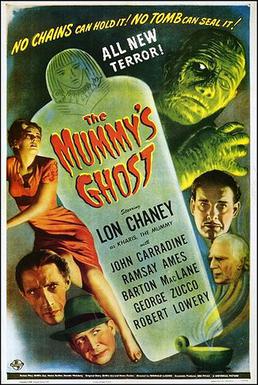
The Mummy's Ghost is a 1944 American horror film directed by Reginald Le Borg for Universal. It is the second of three sequels to The Mummy's Hand (1940), following The Mummy's Tomb (1942) and preceding The Mummy's Curse (1944). Lon Chaney Jr. again takes on the role of Kharis the mummy.

The Mad Ghoul is a 1943 American horror film directed by James Hogan and starring Turhan Bey, Evelyn Ankers, and David Bruce, and featuring George Zucco, Robert Armstrong, and Milburn Stone. The film is about the scientist Dr. Alfred Morris and his assistant Ted Allison. Morris, who is obsessed with an ancient Mayan life-preserving process to the point of madness, has fallen in love with Allison's girlfriend, the concert singer Isabel Lewis. Morris decides to use Allison for his eternal-life experiments, transforming him into a zombie who slowly recalls his past life, but is unaware of his undead status.
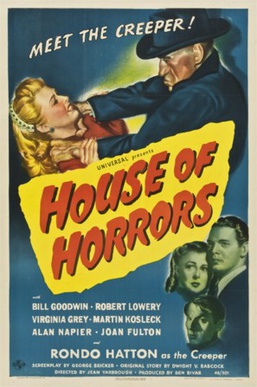
House of Horrors is a 1946 American horror film released by Universal Pictures, starring Rondo Hatton as a madman named "the Creeper".
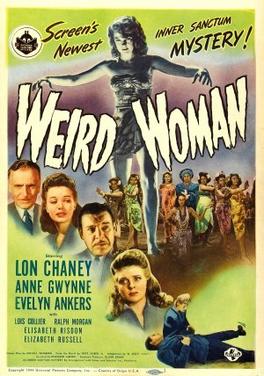
Weird Woman is a 1944 noir-mystery horror film, and the second installment in The Inner Sanctum Mysteries anthological film series, which was based on the popular radio series of the same name. Directed by Reginald Le Borg and starring Lon Chaney Jr., Anne Gwynne, and Evelyn Ankers. The movie is one of several films based on the novel Conjure Wife by Fritz Leiber. Co-star Evelyn Ankers had previously worked with Chaney in Ghost of Frankenstein, where Chaney played the Frankenstein monster, and The Wolf Man, where Chaney played the title role.

Dead Man's Eyes is a 1944 noir-mystery film, and the second installment in The Inner Sanctum Mysteries anthological film series, which was based on the popular radio series of the same name. Directed by Reginald Le Borg, and starring Lon Chaney Jr. and Jean Parker, the movie was distributed by Universal Pictures.
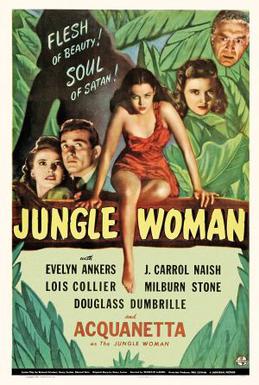
Jungle Woman is a 1944 American horror film directed by Reginald LeBorg. The film stars Evelyn Ankers, J. Carrol Naish, Samuel S. Hinds, Lois Collier and Acquanetta. Jungle Woman was the second film in Universal's Cheela, the Ape Woman series, preceded by Captive Wild Woman.
Reginald LeBorg was an Austrian-American film director. He directed 68 films between 1936 and 1974.

Frankenstein is a film series of horror films from Universal Pictures based on the play version by Peggy Webling and the 1818 novel Frankenstein; or, The Modern Prometheus by Mary Shelley. The series follow the story of a monster created by Henry Frankenstein who is made from body parts of corpses and brought back to life. The rest of the series generally follows the monster continuously being revived and eventually focuses on a series of cross overs with other Universal horror film characters such as The Wolf Man. The series consists of the following films: Frankenstein (1931), Bride of Frankenstein (1935), Son of Frankenstein (1939), The Ghost of Frankenstein (1942), Frankenstein Meets the Wolf Man (1943), House of Frankenstein (1944), House of Dracula (1945) and Abbott and Costello Meet Frankenstein (1948).
Dracula is a film series of horror films from Universal Pictures based on the 1897 novel Dracula by Bram Stoker and its 1927 play adaptation. Film historians had various interpretations of what constitutes being in the film series, with academics and historians finding narrative continuation between Dracula (1931) and Dracula's Daughter (1936) with varying different opinions on if Son of Dracula (1943), House of Frankenstein (1944) and House of Dracula (1945) were part of the series. Author and academic Gary Don Rhodes stated the all the mentioned films would require an audience to be familiar with Count Dracula portrayed by Bela Lugosi and the various character traits the actor established in the original 1931 film.

The Inner Sanctum Mysteries film series consists of American classic-horror mystery films, based on and inspired by the works of Himan Brown, and the stories printed by Simon & Schuster.
